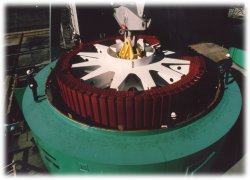Generator Rehabilitation
Many of the USACE powerplants have been in operation for over 50 years. The cumulative effects of age and operating cycles are showing up as a pattern of major breakdowns that indicates declining reliability. Engineering analysis shows that even with increased maintenance, these problems can be expected to continue and cause generating unit outages to increase. Increased outages cause increased operation and maintenance costs, and increased production costs for the power system.
The component of electrical equipment most prone to deterioration over time in service is the winding insulation system. The winding insulation is exposed to many aging mechanisms, which shorten its life, including electrical and mechanical stresses during normal operation. Other components of the winding system used to contain the windings within the stator laminations can also lose strength and elasticity when exposed to these stresses, eventually resulting in unwanted winding movement and eventual failure. It is not uncommon to exceed 200,000 hours of generator operation before winding failures begin occurring.
When the stator winding insulation fails, the high voltage generated in the coils arcs to the surrounding framework, and protective relaying shuts down the generating unit. The unit must be repaired before it can be restarted. Different types of repairs are possible depending upon the age and condition of the generating unit. If damage is limited to one or two coils, the repair usually consists of removing the damaged coils from the circuit by jumpering around these coils. More extensive failures require partial or complete stator winding replacement. Stator winding failures usually damage the stator core. Rotor damage is also common. Replacing deteriorating stator windings on a  planned schedule allows the design and manufacturing phases to be performed while the unit is still in service. This minimizes the impact on unit availability. If rewinding is performed in conjunction with turbine repairs, some of the unit disassembly and reassembly expenses can be shared between the activities. Reliability and economic analysis of each winding ensures that they have reached the point at which a rewind is the best action. Planned, scheduled rewinds will generally provide the most cost-effective means to maintain the reliability of old generators.
planned schedule allows the design and manufacturing phases to be performed while the unit is still in service. This minimizes the impact on unit availability. If rewinding is performed in conjunction with turbine repairs, some of the unit disassembly and reassembly expenses can be shared between the activities. Reliability and economic analysis of each winding ensures that they have reached the point at which a rewind is the best action. Planned, scheduled rewinds will generally provide the most cost-effective means to maintain the reliability of old generators.
The above photo is of Hartwell Dam generator unit #5 during construction.
